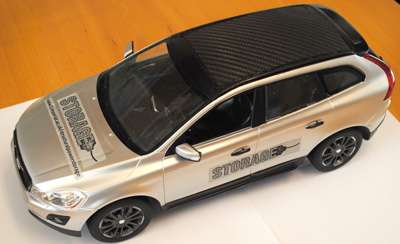In the research on structural batteries, basic science and technological application cross paths. "You really must take a good look at this kind of innovative concepts," says Patrik Johansson. Credit: Emilia Lundgren
The weight of the battery is one of the largest obstacles to overcome for electric and hybrid vehicles. By using the battery as part of the chassis significant weight reductions are possible. In a recently completed EU/FP7-funded project on structural batteries, one of the participants was Prof. Patrik Johansson at Applied Physics, Chalmers, likewise one of our SHC researchers.
"We have investigated materials that can store and deliver energy and also carry load, says Patrik Johansson. The idea is neither to make the best energy storage nor the best construction material. But the compromise, the 'multi-functionality', is really unique."
The batteries are made as laminates and are extremely strong. Patrik Johansson shows something most of all looking like a weave of carbon fibres, a few millimetres thick.
"This is a composite of glass fibres and carbon fibres. It is moldable as any composite. Within there is a special electrolyte, not a liquid, but based on a gel polymer matrix. In our research group we have foremost investigated the transport properties of this kind of electrolytes."
The anode and the cathode of the battery consist of carbon fibres, a glass fibre weave functions as the separator – with a special electrolyte contained – while the current collector is copper foil.
Composite materials for reduced weight
The thin and flat batteries are shaped to be part of the chassis of the car. This way the parts that need mechanical strength also be used to contain energy. For example batteries have been integrated in the plenum cover, replacing metal by the lighter composite material. The gain is a severely reduced weight. This construction was made by Volvo Car Corporation – a partner in the project.
To combine energy storage with mechanical strength is a unique compromise. In the model above, the car roof has been replaced by a structural battery. Credit: Emilia Lundgren
"With this basic idea we avoid the battery being solely a 'burden' for the vehicle, says Patrik Johansson. This conceptual thinking we keep in mind for future projects."
Partial replacement for traditional car batteries
The aims with the structural batteries are to provide enough energy to relieve the traditional 12 V battery and to be chargeable also from an external source. They will, however, not likely be enough for the propulsion of an electric car.
"As I see it today, we will not be able to store enough energy to enable vehicle propulsion," says Patrik Johansson.
Many issues remain to be solved regarding the integration in vehicles of these batteries from a production perspective, but Patrik Johansson anyway believes that structural batteries have a bright future.
"Yes, I firmly believe so. However, it is not at all for sure that the final implementation will be in vehicles. Vehicles have very tough demands on safety, cost, and recycling. But there are perhaps other niches in the future, unknown to us at present. It is the basic idea and the concept itself that is cool!"
Provided by Chalmers University of Technology























